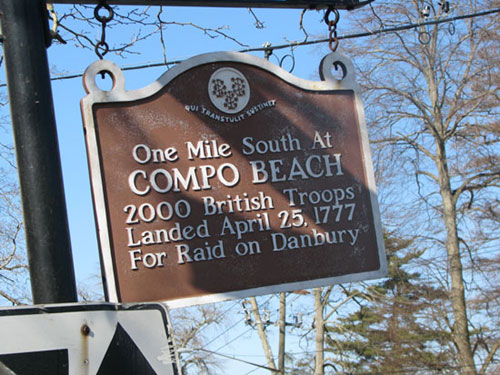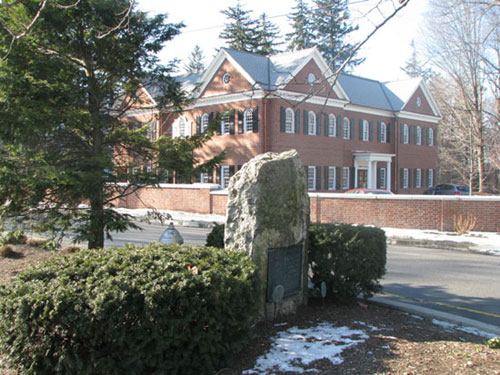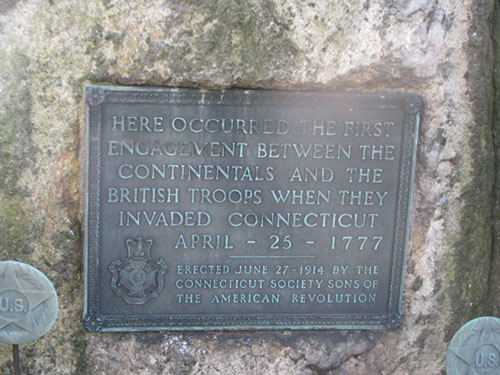|
April
26, 1777 British Raid on Danbury, Connecticut
British
Raid of Danbury, 1777
The
British Army's march through Redding Ridge is the only direct
contact Redding residents had with British troops in the Revolution.
It created much excitement and afforded the Collier's an opportunity
to bring that excitement to life in my brother Sam is dead.
Twenty-four vessels carrying around 1,550 regular British
troops and some 300 Loyalist militiamen from "Browne's Provincial
Corps", many of whom were originally from Connecticut, arrived
on the shores of Compo Beach in Westport, Connecticut on April
25, 1777. Their mission: destroy the rebel military supply
depot at Danbury, Connecticut.

Lord
Howe, the commander of the British troops, stationed at New
York City, had long meditated an attack on Connecticut and
news of provisions being stored at Danbury provided the incentive
he desired. Howe chose William Tryon, the deposed British
governor of New York, as Commander and two military men: Brigadier
General James Agnew, second in command and Brigadier General
Sir William Erskine as third in command for the expedition.
Tryon
had been Governor of New York up until the Revolution and
was said to have been consumed with "an inveterate hatred
and thirst for revenge" on the rebel Yankees. He had a special
grudge against Connecticut, the sturdy little colony that
had thwarted him in a variety of ways: "Her horseman had scattered
organs of revolutionary propaganda through the streets of
New York; her "Sons of Liberty" had plotted against him even
in his own city; treated with contempt his proclamations,
using them as specimens of the governor's pleasant humor."
Tryon
had the further merit of being intimately acquainted with
the towns and landscape of Connecticut. He had been as far
inland as Litchfield, had probably visited Danbury, and had
been dined and feted at Norwalk, Fairfield, and New Haven.
He seems to have acted as a *guide to the expedition while
giving **Agnew and Erskine the responsibility of tactical
operations.
*Tryon
was aided by local Tories who had fled from the area and joined
the British army. The locals intimate knowledge of the roadways
and landscape in and around Southwestern Connecticut was a
vital asset to the British troops.
**Agnew
was injured at some point during the weekend and Erskine took
over as second in command.; He was very capable in that role.
Earlier that winter, Erskine had led a foraging expedition
to New Jersey in which "he routed the rebels with great slaughter;
he took no prisoners."
Via
40 or 50 flatboats the troops disembarked at Compo between
five and six in the afternoon, and that same evening marched
to Fairfield, about seven miles distant, where they encamped
for the night.
News
that the British had landed at Compo, encamped at Fairfield,
and would march through Redding the next day, was conveyed
to the residents at an early hour, and occasioned the greatest
consternation and excitement. Money and valuables were hastily
secreted in wells and other places of concealment; horses
and cattle were driven into the forests, and the inhabitants
along the enemy's probable route held themselves in readiness
for instant flight.

Location of first engagement between the British and local
militia. Corner of Post Road & Compo Beach Road, Westport,
Connecticut.

On
receiving intelligence of the landing at Compo, Captain Zalmon
Read mustered his company of militia, and forthwith marched
to intercept the invaders. At a place called Couch's Rock,
in Weston, Connecticut, they came suddenly upon a British
flanking company and were taken as prisoners. Town selectman,
James Rogers, Timothy Parsons, Russell Bartlett and 13 year
old, Jacob Patchen were among the prisoners. In Charles Burr
Todd's History of Redding, Todd relates that:
"Timothy
Parsons, had a fine musket which he particularly valued; this
a British soldier took, and dashed to pieces on the stones,
saying it should waste no more rebel bullets."
Meanwhile,
Colonel Joseph Platt Cooke, commander of the 16th militia
regiment in Danbury, had followed General Gold S. Silliman's
instructions and sent all available men from Danbury to Fairfield.
Silliman mistakenly assumed that the British intended to attack
Fairfield. Other troops were sent toward the Hudson River,
in response to a number of ships the British had strategically
positioned there to confuse the American generals. This left
the Military Depot at Danbury in a vulnerable state.
On
the morning of the 26th, at a very seasonable hour (11am-12
noon), the British troops arrived and halted at Redding Ridge.
During the halt the main body of the troops remained under
arms on the green in front of the Anglican Church. Tryon,
Agnew, and Erskine were invited into Esquire William Heron's
home (the first house south of the Christ Church Episcopal,
no longer in existence). Here they were reported to have been
"hospitably entertained with cake, wine, and it is presumed,
many hopeful prognostications of the speedy collapse of the
rebellion."
Shortly
after their meeting, a file of soldiers entered the house
of Lieutenant Stephen Betts, a prominent patriot who lived
across the street from the church and seized him. Daniel Sanford,
his son, Jeremiah Sanford (19 years old), and 16 year old,
Benjamin Lines, met a like fate. Three of Redding's loyalists
joined British Troops on this day: Samuel Hawley, James Gray,
and Joseph Lyon. Lyon had been in hiding for 33 days.
As
the army prepared to resume its march north, a horseman was
observed spurring rapidly down *Couch Hill Road (present day-
Sunset Hill Road) toward them. He was within musket shot before
discovering their presence and though he turned to fly when
he saw their red coats, he was shot, and severely wounded
in the attempt. He proved to be a messenger from Colonel Cooke
in Danbury, bearing dispatches to General Silliman. His name
was Lambert Lockwood. Tryon had formerly known him in Norwalk,
where Lockwood had rendered him a service, and Tryon seems
to have acted on this occasion with some kindness, as he released
him on parole, and allowed him to be taken into a house so
his wounds could be dressed.
*Bethel,
CT historians have the same narrative occurring on Hoyt's
Hill in Bethel. Luther Holcolm is the unfortunate horseman
in Bethel's rendition of the story. Whomever the horseman
actually was he was likely carrying an S.O.S. from Cooke;
Danbury was in grave danger.
All
in all, the British troops spent one to two hours on Redding
Ridge before resuming their march to Danbury with the **Redding
militiamen captured in Weston, Patriots Stephen Betts, Daniel
Sanford, Jeremiah Sanford and a non-combatant (B. Lines) captured
in Redding. One British soldier, Bernard Keeler, deserted
at Redding Ridge and lived in town until his death in 1827.
**Betts,
Bartlett, Lines, Patchen, and most of the Redding militiamen
would all eventually return to Redding. Daniel Sanford, Jeremiah
Sanford, Daniel Chapman, and David Fairchild died in captivity
while being held in the "sugar houses" of New York, where
sanitation was deplorable and disease was rampant.
As
the British marched toward Danbury, the remaining patriots
of Redding anxiously awaited the approach of the Patriot troops
in pursuit. At length they came in view, marching wearily,
in sodden, disordered ranks, a small army of five hundred
men and boys, led by Brigadier General Silliman. They were
comprised of soldiers from the companies of Colonel Lamb's
battalion of artillery, with three rusty cannon, a field-piece,
part of the artillery company of Fairfield, and sixty Continentals;
the rest were an untrained assemblage, chiefly old men and
boys. It was eight o'clock in the evening when the troops
arrived at Redding Ridge-an evening as disagreeable as a northeast
rainstorm with its attendant darkness could make it. Here
the troops halted an hour for rest and refreshment. At the
expiration of that time a bugle was heard from far down the
turnpike; then the tramp of horsemen was heard and presently
Major General Wooster and Brigadier General Arnold, dashed
into the village of Redding Ridge.
On
hearing that the British were so far ahead, it is said that
Arnold became so enraged that he could scarcely keep his seat,
and his terrible oaths fell on his auditor's ears like thunder
claps. Wooster at once assumed command, and the column moved
forward through the muddy and heavily rutted roadway as far
as Bethel, where it halted for the night.
At
Danbury, but three miles distant, Tryon's force was at rest,
and might have been annihilated by a determined effort, but
the Continental command was hampered by the weather conditions,
heavily rutted roadways and fatigue.
Benedict
Arnold to McDougall, West Redding, April 27th, 1777, 10am:
"Last
night at half past eleven, General Wooster, General Silliman
and myself with six hundred militia arrived at Bethel, *eight
miles from Danbury. The excessive heavy rains rendered their
arms useless, and many of the troops were much fatigued having
marched thirty miles in the course of the day without refreshment."
*distances
from Danbury vary from 2.5 miles to 8 miles, depending on
who is reporting back to their superiors. In this case Arnold
incorrectly states they were 8 miles from Danbury; They were
within 3 miles of Danbury, at the intersection of Elizabeth
Street and Blackman Avenue.
The
British had reached Danbury at approximately 5:00 pm and driven
off the Patriots who had been attempting to remove supplies.
Later that evening, seven patriot defenders who had stayed
behind opened fire on British troops from a house in town
owned by Major Daniel Starr, among the patriots was "Ned",
a slave of Redding's Samuel Smith. Two companies of British
regulars charged and put the dwelling to the torch killing
all the men inside.
*This
was the story behind the beheading of Ned in My Brother Sam
is Dead.
Before
their departure early the next morning, the British had destroyed
much of the Rebel's depot: barrels of pork and beef, barrels
of flour, bushels of grain, hogsheads of rum and wine, thousands
of shoes, stockings and tents among other supplies. Provisions
the Continental troops would long for come the winter of 1778-79.
Following
the events of April 26th and 27th, Redding played a supporting
role to the Continental army's efforts in the War of Independence.
May
8, 1778, Captain Zalmon Read and Asahel Fitch were appointed
to provide "shirts, shoes, stockings and other articles of
clothing for the Continental soldiers."
December
17, 1778, another committee was appointed to care for the
families of the following soldiers from Redding: Nathan Coley,
Stephen Meeker, Elias Bixby, Jeremiah Sherwood, Samuel Remong.
These soldiers were among General Israel Putnam's encampment
in Redding.
Online
presentation about Redding
Ridge and My Brother Sam is Dead.
Online
presentation about Keeler
Tavern and My Brother Sam is Dead
Be sure to check out: Locations
& Towns Mentioned in My Brother Sam is Dead
Google
Map of Redding with information about My Brother Sam is Dead
added
Please feel
free to email me with any questions @ bcolley@colleyweb.com.
|

